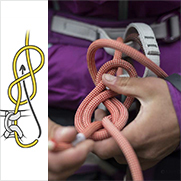AXIS 11 mm with sewn termination
Low stretch kernmantel rope with sewn termination and good handling, for work at height
Auxiliary open brake for I'D®
Auxiliary open brake for I'D S, I'D L and I'D EVAC self-braking descenders
Auxiliary closed brake for I'D®
Auxiliary closed brake for I'D S, I'D L and I'D EVAC self-braking descenders
Tower rescue: skate block with REEVE
REEVE allows an efficient and clean setup of all the necessary equipment.
Video - How to install the ASAP/ASAP LOCK on a lifeline?
This video presents installing the ASAP/ASAP LOCK on a lifeline.
Descending With Additional Braking
Ease of descent depends on the wear on the device, the rope that is used, and the load. Additional braking can help you avoid being surprised by the descent speed (for example on a new, thin rope). It can also help provide a more controlled and comfortable descent.
Lowering a person with the I'D on the rescuer's harness
When there is no anchor, lowering a person with the I'D on the harness requires special attention.
Remote control of the MAESTRO handle with a cord
The MAESTRO handle has a small hole for attaching a cord (e.g. AIRLINE cord).
How to calculate mechanical advantage
A mechanical advantage haul system reduces the effort required to raise a load. The mechanical advantage obtained is based on the pulley effect.
Releasable anchor with the RIG: lowering system pre-installed on the ground.
The RIG can be used to anchor a rope; this anchor is thus releasable to allow a rescue from the ground.
Performance of the ASAP with a 250 kg load, with the ASAP fixed to an anchor.
Test results for an exceptional situation: fall of a 250 kg mass, arrested by a belay system using the ASAP fixed to an anchor. This corresponds to a two-person rescue situation in which any fall must be carefully avoided.









